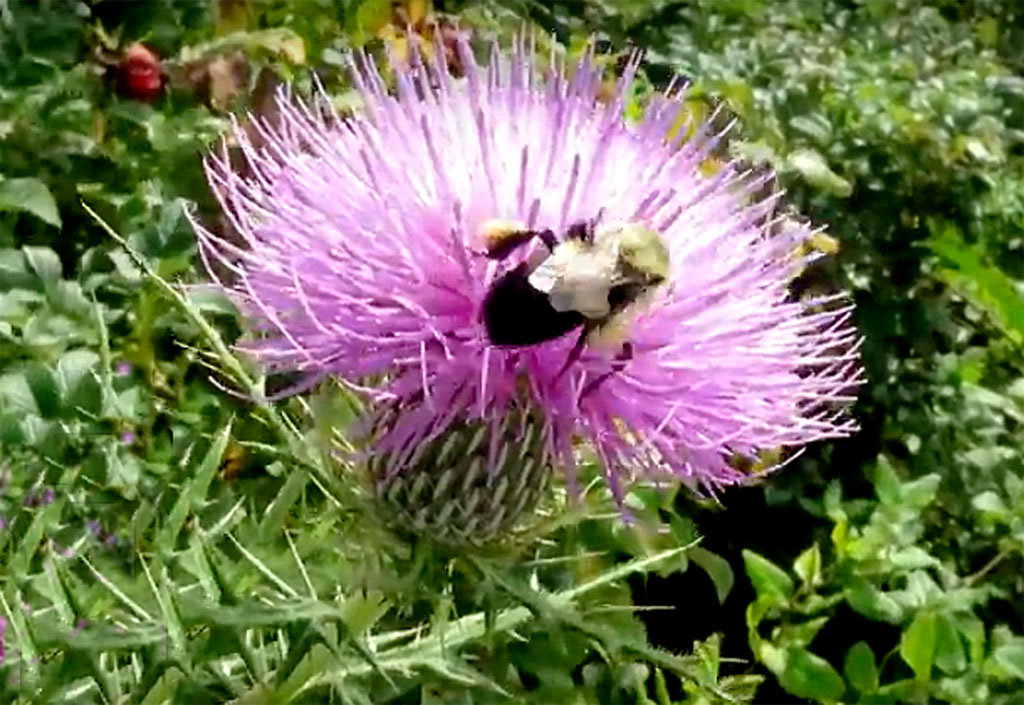
Bumblebee (Bombus impatiens), the eastern bumblebee, on thistle (a native plant) in Demonstration Garden.
A disturbing study published in Feb. 2019, found that more than 40 percent of the world’s insect species could go extinct over the next several decades due in large part to habitat loss, with chemical pollutants, invasive species and climate change as additional causes.
Now, a new study, published in the Feb. 7, 2020 journal, Science, makes a case for climate change as the principle driver of the potential extinction of bumblebees. Scientists said that observers in North America are nearly 50 percent less likely to see a bumblebee in any given area than prior to 1974.
Using a massive dataset, scientists found that bumblebees are less abundant in areas that have become hotter or have experienced extreme temperature swings in the last generation. The researchers concluded that “climate chaos” is the primary driver in the decline of bumblebees. Species are being pushed beyond temperatures they can tolerate, said the scientists.
According to National Geographic, bumblebees are suited to cooler weather, with fuzzy bodies and the ability to generate heat while flying. The last five years were the hottest ever recorded in the 139 years that the U.S. National Oceanic and Atmospheric Administration has tracked global heat.
Honeybees are critical to the propagation of nuts, fruits and vegetables and account for more than $15 billion in the U.S. economy.
The Fishers Island Conservancy COVID 19 protocols
NewsApril 30, 2020
The Fishers Island Conservancy remains cautiously optimistic that some form of an enjoyable summer experience awaits us. So the Parade Ground paths will remain open and accessible as long as folks respect the social distancing guidelines outlined by the State of N.Y. Please keep six feet apart and use the merges to pass when going in opposite directions. All dogs MUST be leashed and they too should be kept at a distance of six feet from unrelated persons. As always, please clean up after your pets.
Also the Thatcher Demonstration Garden is open and remains a pleasant place for reflection. The spring bird migration is in full swing and the Garden is popular stop off point for our migrating avian friends.
At this point, our programming schedule is only tentative. Please stay tuned for further information about Nature Days and potential speakers and children’s programming.
Please note that the Conservancy’s Spring Migration Count will be held Sunday, May 3rd at 9 am. As always, we will meet at the Community Center, only this time only one quarantined family per vehicle. Please bring masks and gloves and your own binoculars. While we are all social distancing for safety’s sake, nature carries on like has done so for thousands of years. Fun to watch.
Be well and be safe.
Cheers,
Tom Sargent
President
Fishers Island Conservancy
Injured Adult Harp Seal Uses the Race for Rest & Recuperation
NewsAdult harp seal, apparently injured, rests at the Race. In photo below, Race Rock Lighthouse in background gives perspective to first sighting of beached seal. Stephanie Hall Photo
This adult harp seal beached itself in high winds at the Race April 21. Stephanie Hall, monitoring the shoreline for FIConservancy, saw the seal and what appeared to be blood near its fin.
The first call is usually to Mystic Aquarium, but its rescue service has been suspended due to Covid-19. Not giving up, Stephanie’s next call was to the U.S. Coast Guard station in New London, which led her to Mystic Aquarium’s veterinarian, and then to The Riverhead Foundation for Marine Research and Preservation in Riverhead, N.Y.
The seal had returned to the water but then beached itself again near the end of the Elizabeth Field runway.
After viewing photos and a video that Stephanie sent to the Riverhead Foundation, Jill at the Foundation offered positive news: “Its injury doesn’t seem too concerning, and the video showed that he is resting comfortably. Hopefully, he will rest and be able to move on once the weather improves.”
Stephanie checked the next morning and the seal was gone.
Social Distancing
NewsIn the age of COVID-19, social distancing works. But painted turtles, the most widespread native turtles in North America, have no such concern. This group gathered April 15 to bask in the sun on the pond near H.L. Ferguson Museum. (sent as email blast 4/17/20) Marlen Bloethe Photo
Signs of Spring
NewsSnowy egret returns in early April to pond near H.L.Ferguson Museum. Marlin Bloethe Photo. Early April daffodils hug the side of a hill next to Fishers Island School. Stephanie Hall Photo
Enduring Comfort
News“When thou art weary I’ll find thee a bed, Of mosses and flowers to pillow thy head.” John Keats (1795-1821). Oyster Pond trail, April 4, 2020. (sent as email blast 4/7/20) Dianne Crary Photo
The Calming Waters of Fishers Island
News“I go to the sea, and the sea…imposes a rhythm upon everything in me…” Rainer Maria Rilke (1875-1926). South Beach, Mar. 24, 2020. Stephanie Hall Photo
With COVID-19 forcing us into an uncertain future, we are fortunate to know the beauty and serenity of Fishers Island’s natural world. Songbirds have returned to the Parade Grounds meadows, and piping plovers will soon be nesting on South Beach.
The constancy of a well-cared-for natural environment on Fishers Island is a gift. Taking a moment to enjoy this image of calm waters off South Beach may bring a brief respite from today’s challenges. There will be better days ahead. (Sent as eblast 3/27/20)
List of Native Grassland and Wildflower Seeds for East End Habitat Restoration Project
NewsList of seeds for FIConservancy/FIDCO habitat restoration project near Middle Farms:
Startling Statistic: Four Tons of Marine Debris Collected on FI Shores in 2019
Beach Cleanup, NewsIn 2019, Island resident Michele Klimczak collected an astounding 8441 pounds of marine debris from the shores of Fishers Island. Michele is employed by FIConservancy to patrol multiple Island locations and clear away marine debris.
FIConservancy Partners with FIDCO in East End Habitat Restoration Project
NewsThe Fishers Island Conservancy is working to extend the success of its West End grassland restoration initiative, and in partnership with FIDCO, has begun a habitat restoration project on the East End near Middle Farms.
Scientists Say “Climate Chaos” is Main Reason for Decline in Bumblebee Population
NewsBumblebee (Bombus impatiens), the eastern bumblebee, on thistle (a native plant) in Demonstration Garden.
A disturbing study published in Feb. 2019, found that more than 40 percent of the world’s insect species could go extinct over the next several decades due in large part to habitat loss, with chemical pollutants, invasive species and climate change as additional causes.
Now, a new study, published in the Feb. 7, 2020 journal, Science, makes a case for climate change as the principle driver of the potential extinction of bumblebees. Scientists said that observers in North America are nearly 50 percent less likely to see a bumblebee in any given area than prior to 1974.
Using a massive dataset, scientists found that bumblebees are less abundant in areas that have become hotter or have experienced extreme temperature swings in the last generation. The researchers concluded that “climate chaos” is the primary driver in the decline of bumblebees. Species are being pushed beyond temperatures they can tolerate, said the scientists.
According to National Geographic, bumblebees are suited to cooler weather, with fuzzy bodies and the ability to generate heat while flying. The last five years were the hottest ever recorded in the 139 years that the U.S. National Oceanic and Atmospheric Administration has tracked global heat.
Honeybees are critical to the propagation of nuts, fruits and vegetables and account for more than $15 billion in the U.S. economy.